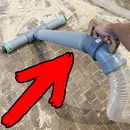Introduction: Woodworking Mallet From Firewood
The best tools are the self-made ones! In this ´ible I will teach you how to turn a log into a woodworking hammer.
This is a perfect project for beginner woodturners as it offers endless design possibilities while requiring minimum skill. The cost of this project is close to zero as the wood comes from firewood.
To get a good overview be sure to watch the video .
But why use a wooden mallet? Wooden mallets will not damage the tools or the surface of the workpiece as much as mallets from other materials. The wood also acts as a shock absorber and takes much of the impact.
I saw a similar mallet being made by Jimmy Diresta back in 2013. His video was the inspiration for this build. Mr Diresta is a true craftsman and if you have not heard about him I suggest you check out his other projects as well. The man is rocking it!
Step 1: Tools and Materials
The only materials you will need are:
- A log from a pile of firewood
- Wood glue
- Spline material if you mess up
- Finishing
When looking for a log, search for ones that are already round. This will make the turning process go much faster.
Tools:
- A lathe (a cheap one will do)
- Lathe tools
- Caliper
- Spade or forstner bit (30mm)
- Sandpaper
- Handsaw
Step 2: Turn the Log to Shape
The first thing, of course, is to turn the log into perfect cylinder. Do this with a very slow speed to minimise the vibration. After that turn the speed up to get a better cut.
Then just slowly turn the log into desired shape starting with the handle.
Finish it off with different grit sandpapers and polish it with wood shavings. I really do not see the point of finishing a wooden hammer with really high grit sandpaper as the tool itself will soon have plenty of dents and imperfections anyway. I use 80, 120 and 180 grit.
After sanding use a hand saw to part it.
Step 3: The Handle
This is the tricky part. You have to turn the end of the handle a tiny bit smaller than the width of your spade bit.
Use a pair of callipers to check the exact size of your bit and subtract just a few millimetres. This will allow a really snug fit later.
Do not worry if you mess up. I did too! I planned on using 32 mm bit in the beginning but ended up getting the handle part bit smaller. I decided to use the next bit that I had which was 30 mm. And.... I messed up this one as well... I did not want to go any smaller so I decided to use splines.
Use handsaw to cut two notches into the handle. Find a piece of wood that is slightly wider than the notches. Cut the splines to shape and sand one end sharp (the splines will go in easier).
The splines have to be exactly as deep as the hole in the hammer head will be, otherwise the handle will be loose or will not go into the head all the way. And do not mess this up - you only have one chance! When the splines have widened the head of the handle you can not get it out anymore.
The last thing is to sand the rim of the handle to compensate the round head profile. Do this with the belt sander. The wheel part on the end works well for this. Check the fit often as you do not want to remove too much material!
Step 4: The Head
To finish the head you have to sand the ends if your woodturning skills are not so great like mine. Turning an end grain is not an easy task with cheap tools. So instead use disc or belt sander to get a nice surface.
But be sure to also round the corners as otherwise the hammer will damage the wood (especially softer woods).
The last thing to do is to drill the hole in the head (well this part should be actually done before the splines step). A tricky part is to drill the hole exactly 90 degrees in both axes. To make this process easier I made a little jig. It is simply a block with a V-groove in it (made with a table saw).
Step 5: Oiling and Branding
And of course, the last step is finishing and branding your hammer.
I used linseed oil but it can be anything as long as it does not leave a mark on the workpiece.
The branding iron I used is a self-made one. I simply carved my name on a piece of copper with small files and rotary tool.
Step 6: The End
Voilà! One homemade wooden hammer.
As you can see I also made a bigger one from birch. This one has sharp edges which is not ideal. It will leave dents on whatever you are hammering when you hit it under a slight angle. Thus I recommend sanding the edges.
All in all, this is a really fun project that will improve your woodturning skills greatly. And of course, it will provide you with endless amounts of wooden hammers.
And the great thing is that you can change the design to your liking. You could make tiny dwarf ones or even a big 2-meter long Warhammer with this method. It is all up to you!
I hope you have enjoyed this project!
Cheers
Andu

Participated in the
Remix Contest 2016

Participated in the
Wooden Toys Challenge 2016













